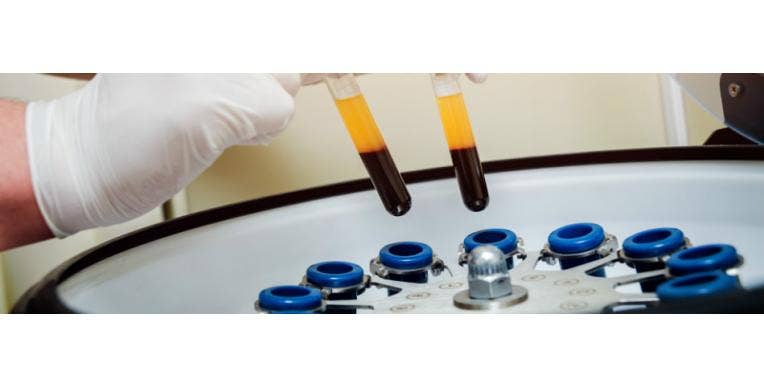What Is The Difference Between Plasma & Serum?
Plasma and serum are two elements of the blood that are commonly thought to be the same thing. However, they are different substances. In this article, we’ll go over what Plasma and Serum are and the key differences between them.
Plasma makes up about 55% of the overall blood volume. It is the liquid portion of blood and is 90% water. Other than water, plasma also contains fibrinogen (which contributes to the normal clotting of blood) and albumin (which acts to keep fluid in your bloodstream and prevent leaking into other tissues). The purpose of plasma in the blood is to transport all the proteins, nutrients, antibodies, hormones, etc., all over the body. As the plasma races around the body, cells deposit their waste into the plasma, which contributes to another plasma job: waste removal.
On the other hand, the serum is plasma minus the clotting factors and blood cells. During the process of removing the clotting factors (achieved by centrifugation), the protein fibrinogen, as described above, is converted to fibrin. Fibrin is an insoluble protein used to assist in the repair of tissue damage by forming a clot over the wound which acts to hinder the flow of blood.
What are the Key Differences Between Plasma & Serum?
A key difference between plasma and serum is that plasma is liquid, and serum is fluid. While most of the components are the same for both plasma and serum, plasma contains fibrinogen which is absent in serum. Both plasma and serum can be extracted from blood with the use of a centrifuge, but it’s worth noting that serum is obtained after the clotting of blood, while plasma can be obtained before the coagulation of the blood. The serum is mostly used for blood typing however, is also used for diagnostic testing. Plasma, on the other hand, is mostly used for blood clotting.
The Importance of Blood Clotting
Blood clotting is an essential process that involves a cascade of proteases that convert prothrombin to thrombin, which then converts fibrinogen into fibrin to form a blood clot. Platelets are also activated in this process, releasing compounds that can naturally alter proteins in the serum. However, collecting plasma for testing requires the addition of anticoagulants, such as EDTA, which chelates the calcium needed for clotting. While these anticoagulants can impact testing, their appropriate use is crucial for accurate diagnostic results.
How to Extract Plasma and Serum from Whole Blood?
Serum and plasma can be extracted from the blood through a process called centrifugation. The sample of the blood is collected in a tube and then spun in a centrifuge to separate the components by density. This separates the blood into three layers: plasma or serum at the top, a thin layer of platelets and white blood cells in the middle, and red blood cells at the bottom. Plasma is obtained by collecting the top layer, while serum is obtained by collecting the liquid left over after blood has clotted and the clot has been removed. Both plasma and serum can then be stored and used for various diagnostic, research, or clinical purposes.
Buy Quality Centrifuges & Lab Equipment from Westlab Canada
Westlab Canada, with its advanced laboratory design and equipment, is dedicated to supporting significant discoveries and breakthrough research. Committed to fostering scientific progress, we provide innovative medical and scientific solutions. Peruse our comprehensive selection of centrifuges and laboratory accessories at Westlab, designed to optimize experimental efficiency. Allow Westlab to facilitate your next discovery in a professional and formal manner.
FAQs
What is the difference between plasma and serum and whole blood?
Plasma is the component of blood that remains after red blood cells, white blood cells, and platelets are removed. Serum is the other component of blood that remains after coagulation factors have been removed from the plasma. Whereas whole blood is the combination of all components of blood, including red and white blood cells, platelets, plasma, and serum.
What are the advantages of plasma over serum?
Plasma can measure coagulation factors and contains fibrinogen, allowing for additional testing related to blood clotting. Additionally, plasma can be used for some molecular diagnostic tests, such as PCR, without interference from clotting factors. Serum can be easier to obtain and store and is often preferred for some types of diagnostic testing. Ultimately, the choice between plasma and serum depends on the specific testing needs and limitations.
Why is the serum test conducted?
Serum tests are conducted to measure the levels of various substances, such as hormones, proteins, electrolytes, and enzymes, in the blood serum. These tests are used to diagnose and monitor medical conditions, such as liver and kidney disease, metabolic disorders, autoimmune diseases, and cancer.
When to use serum, plasma, or both?
Whether you’re developing a diagnostic test, supplementing a cell culture, or running a research assay, we highly recommend utilizing both serum and plasma. You should not rely on only one sample type as it may result in misleading results due to the interference or alteration of results by the clotting factors in serum or the platelets and cellular elements that contaminate plasma. Conducting tests on both sample types provides a more accurate representation of how different sample types behave.


